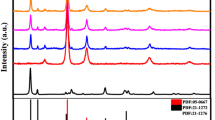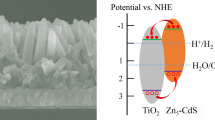Abstract
In this work, two kinds of ZnO/Cu2S core/shell nanorods (NRs) have been successfully synthesized from ZnO NRs for photoelectrochemical (PEC) water splitting by a versatile hydrothermal chemical conversion method (H-ZnO/Cu2S core/shell NRs) and successive ionic layer adsorption and reaction method (S-ZnO/Cu2S core/shell NRs), respectively. The photoelectrode is composed of a core/shell structure where the core portion is ZnO NRs and the shell portion is Cu2S nanoparticles sequentially located on the surface. The ZnO NRs array provides a fast electron transport pathway due to its high electron mobility properties. The optical property of both two kinds of core/shell NRs was characterized, and enhanced absorption spectrum was discovered. Our PEC system produced very high photocurrent density and photoconversion efficiency under 1.5 AM irradiation for hydrogen generation. On the basis of a versatile chemical conversion process based on the ion-by-ion growth mechanism, H-ZnO/Cu2S core/shell NRs exhibit a much higher photocatalytic activity than S-ZnO/Cu2S core/shell NRs. The photocurrent density and photoconversion efficiency of H-ZnO/Cu2S core/shell NRs are up to 20.12 mA cm−2 at 0.85 V versus SCE and 12.81 % at 0.40 V versus SCE, respectively.







Similar content being viewed by others
References
Tachibana Y, Vayssieres L, Durrant JR (2012) Artificial photosynthesis for solar water-splitting. Nat Photonics 6:511–518
Linic S, Christopher P, Ingram DB (2011) Plasmonic-metal nanostructures for efficient conversion of solar to chemical energy. Nat Mater 10:911–921
Chen CC, Ma WH, Zhao JC (2010) Semiconductor-mediated photodegradation of pollutants under visible-light irradiation. Chem Soc Rev 39:4206–4219
Li YB, Takata T, Cha D, Takanabe K, Minegishi T, Kubota J, Domen K (2013) Vertically aligned Ta3N5 nanorod arrays for solar-driven photoelectrochemical water splitting. Adv Mater 25:125–131
Fujishima Akira, Honda Kenichi (1972) Electrochemical photolysis of water at a semiconductor electrode. Nature 238:37–38
Pu YC, Wang GM, Chang KD, Ling YC, Lin YK, Fitzmorris BC, Liu CM, Lu XH, Tong YX, Zhang JZ, Hsu YJ, Li Y (2013) Au nanostructure-decorated TiO2 nanowires exhibiting photoactivity across entire UV–visible region for photoelectrochemical water splitting. Nano Lett 13:3817–3823
In SC, Chen ZB, Arnold JF, Dong RK, Pratap MR, Thomas FJ, Zheng XL (2011) Branched TiO2 nanorods for photoelectrochemical hydrogen production. Nano Lett 11:4978–4984
Guo KY, Liu ZF, Zhou CL, Han JH, Zhao YF, Liu ZC, Li YJ, Cui T, Wang B, Zhang J (2014) Fabrication of TiO2 nano-branched arrays/Cu2S composite structure and its photoelectric performance. Appl Catal B 154:27–35
Wolcott A, Smith WA, Kuyke TR, Zhao YP, Zhang JZ (2009) Photoelectrochemical study of nanostructured ZnO thin films for hydrogen generation from water splitting. Adv Funct Mater 19:1849–1856
Sivula K, Formal FL, Grätzel M (2009) WO3–Fe2O3 photoanodes for water splitting: a host scaffold, guest absorber approach. Chem Mater 21:2862–2867
Hong SJ, Lee S, Jang JS (2011) Heterojunction BiVO4/WO3 electrodes for enhanced photoactivity of water oxidation. Energy Environ Sci 4:1781–1787
Weinhardt L, Blum M, Bär M (2008) Electronic surface level positions of WO3 thin films for photoelectrochemical hydrogen production. J Phys Chem C 112:3078–3082
Paracchino A, Laporte V, Sivula K (2011) Highly active oxide photocathode for photoelectrochemical water reduction. Nat Mater 10:456–461
Tada H, Kiyonaga T, Naya SI (2009) Rational design and applications of highly efficient reaction systems photocatalyzed by noble metal nanoparticle-loaded titanium(IV) dioxide. Chem Soc Rev 38:1849–1858
Chung J, Myoung J, Oh J, Lim S (2010) Synthesis of a ZnS shell on the ZnO nanowire and its effect on the nanowire-based dye-sensitized solar cells. J Phys Chem C 114:21360–21365
Beek WJE, Wienk MM, Janssen RAJ (2006) Hybrid solar cells from regioregular polythiophene and ZnO nanoparticles. Adv Funct Mater 16:1112–1116
Dick KA, Deppert K, Larsson MW, Martensson T, Seifert W, Wallenberg LR, Samuelson L (2004) Synthesis of branched ‘nanotrees’ by controlled seeding of multiple branching events. Nat Mater 3:380–384
Zhang QE, Chou TP, Russo B, Jenekhe SA, Cao GZ (2008) Polydisperse aggregates of ZnO nanocrystallites: a method for energy-conversion-efficiency enhancement in dye-sensitized solar cells. Adv Funct Mater 18:1654–1660
Gonzalez VI, Lira CM (2009) Vertically-aligned nanostructures of ZnO for excitonic solar cells: a review. Energy Environ Sci 2:19–34
Khanchandani S, Kundu S, Patra A, Ganguli AK (2012) Shell thickness dependent photocatalyic properties of ZnO/CdS core-shell nanorods. J Phys Chem C 116:23653–23662
Plank NV, Snaith HJ, Ducati C, Bendall JS, Schmidt-mende L, Welland ME (2008) A simple low temperature synthesis route for ZnO–MgO core-shell nanowires. Nanotechnology 19:1–8
Wang K, Chen JJ, Zhou WL, Zhang Y, Yan YF, Pern J, Mascarenhas A (2008) Direct growth of highly mismatched type II ZnO/ZnSe core/shell nanowire arrays on transparent conducting oxide substrates for solar cell applications. Adv Mater 20:3248–3253
Xiu FX, Yang Z, Mandalapu LJ, Zhao DT, Liu JL, Beyermann WP (2005) High-mobility Sb-doped p-type ZnO by molecular-beam epitaxy. Appl Phys Lett 87:1–3
Wang EJ, He T, Zhao LS, Chen YM, Cao YM, Cao YA (2011) Improved visible light photocatalytic activity of titania doped with tin and nitrogen. J Mater Chem 21:144–150
Liu CC, Liu ZF, Li JW, Han JH, Wang Y, Liu ZC, Ya J (2013) Cu-doping ZnO/ZnS nanorods serve as the photoanode to enhance photocurrent and conversion efficiency. Microelectron Eng 103:12–16
Yang LL, Zhang ZQ, Yang JH, Yan YS, Sun YF, Cao J, Gao M, Wei MB, Lang JH, Liu ZF, Wang Z (2012) Effect of tube depth on the photovoltaic performance of CdS quantum dots sensitized ZnO nanotubes solar cells. J Alloy Compd 543:58–64
Vogel R, Hoyer P, Weller H (1994) Quantum-sized PbS, CdS, Ag2S, Sb2S3, and Bi2S3 particles as sensitizers for various nanoporous wide-bandgap semiconductors. J Phys Chem 98:3183–3188
Reiss P, Protière M, Li L (2009) Core/shell semiconductor nanocrystals. Small 2:154–168
Liu CC, Liu ZF, Li YB, Liu ZC, Wang Y, Ya J, Gargiulo N, Caputo D (2012) Enhanced visible-light-responsive photocatalytic property of CdS and PbS sensitized ZnO nanocomposite photocatalysts. Mater Sci Eng B 177:570–574
Li YX, Hu YF, Peng SQ, Lu GX, Li SB (2009) Synthesis of CdS nanorods by an ethylenediamine assisted hydrothermal method for photocatalytic hydrogen evolution. J Phys Chem C 113:9352–9358
Gorai S, Ganguli D, Chaudhuri S (2004) Synthesis of 1D Cu2S with tailored morphology via single and mixed ionic surfactant templates. Mater Chem Phys 88:383–387
Lai YK, Lin ZQ, Zheng DJ, Chi LF, Du RG, Lin CJ (2012) CdSe/CdS quantum dots co-sensitized TiO2 nanotubes array photoelectrode for highly efficient solar cells. Electrochim Acta 79:175–181
Tak Y, Hong SJ, Lee JS, Yong K (2009) Fabrication of ZnO/CdS core/shell nanowire arrays for efficient solar energy conversion. J Mater Chem 19:5945–5951
Liu ZF, Ya J, Xin Y (2009) Growth of ZnO nanorods by aqueous solution method with electrodeposited ZnO seed layers. Appl Surf Sci 255:6415–6420
Zhang ZH, Wang P (2012) Optimization of photoelectrochemical water splitting performance on hierarchical TiO2 nanotube arrays. Energy Environ Sci 5:6506–6512
Acknowledgments
The authors gratefully acknowledge the financial support from the Research Foundation for Hubei Provincial Key Laboratory of Green Materials for Light Industry (No. 20130108).
Author information
Authors and Affiliations
Corresponding authors
Rights and permissions
About this article
Cite this article
Guo, K., Chen, X., Han, J. et al. Synthesis of ZnO/Cu2S core/shell nanorods and their enhanced photoelectric performance. J Sol-Gel Sci Technol 72, 92–99 (2014). https://doi.org/10.1007/s10971-014-3426-1
Received:
Accepted:
Published:
Issue Date:
DOI: https://doi.org/10.1007/s10971-014-3426-1




